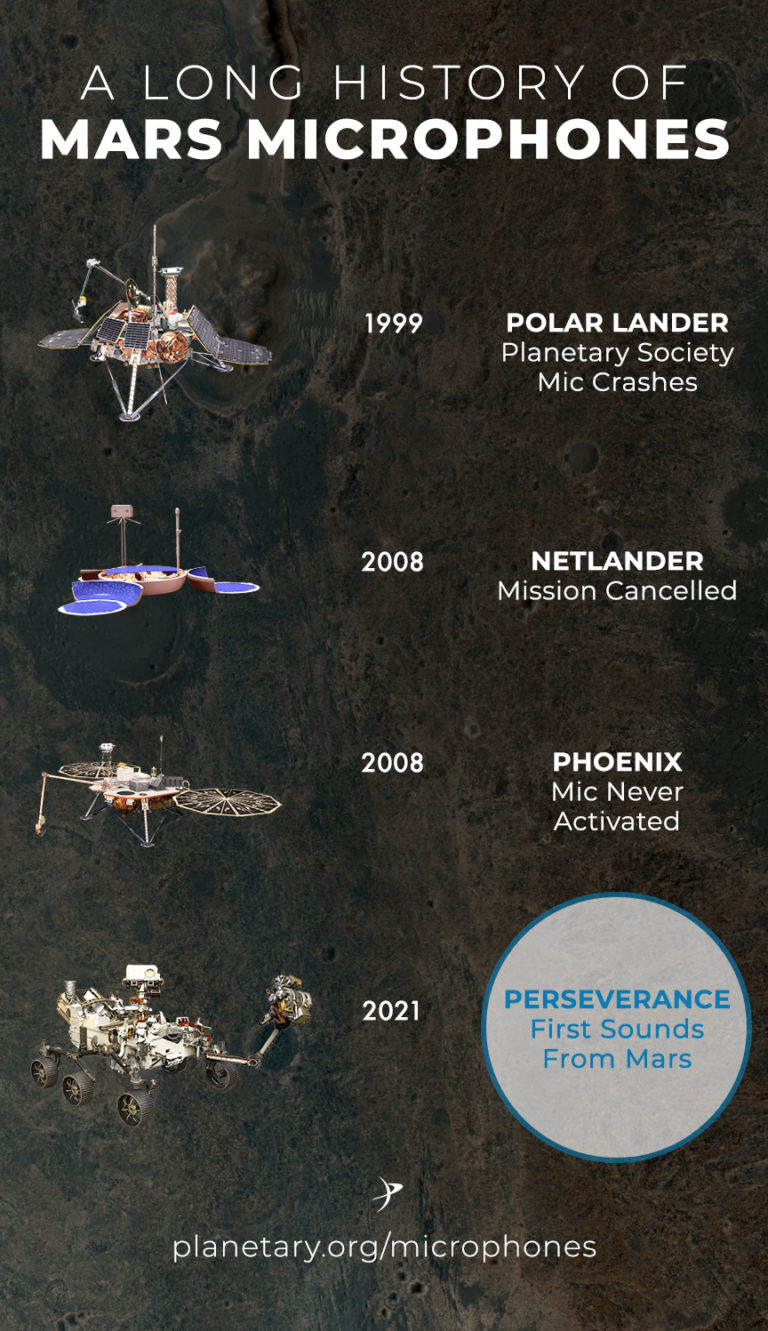Mars Microphones
Thanks to microphones sent to Mars in 2021 aboard NASA's Perseverance rover, we now know what Mars sounds like. The audio from the Red Planet fulfills a 25-year Planetary Society campaign that began with a letter co-founder Carl Sagan wrote to NASA in 1996, urging the agency to include a microphone aboard its next Mars lander:
"Even if only a few minutes of Martian sounds are recorded from this first experiment, the public interest will be high and the opportunity for scientific exploration real," Sagan wrote.
Planetary Society members and supporters funded the world's first Mars microphone on NASA's Mars Polar Lander, which launched in 1999. It was the first citizen-funded science experiment to fly to another world. Sadly, the spacecraft crashed on Mars later that year.
We were scheduled to refly the microphone experiment on a French Mars mission called Netlander that was ultimately canceled in 2004. NASA's Mars Phoenix lander had a microphone aboard, but it had to be turned off before launch due to last-minute technical difficulties.
In 2016, NASA announced it was including two microphones on its Perseverance rover mission. Perseverance sent back its first audio clips shortly after landing in 2021.

Perseverance's Microphones
Given that sound waves need an atmospheric medium through which to travel, many people are surprised to learn that any sounds at all can be heard on Mars. The atmospheric pressure on the Red Planet’s surface is small, amounting to less than 1% of Earth's sea level pressure. But even at Mars' low pressure, acoustic signals within the frequency range of the human ear can be detected.
Perseverance is equipped with two microphones: a descent mic to record and transmit audio as Perseverance executes its complicated landing procedure, and a Supercam microphone to listen as the rover’s laser zaps rocks. On Earth, the laser makes a distinct popping noise as it strikes its target. The descent mic did not record any usable audio during the landing procedure.
Amazingly, the sound a rock makes when Perseverance's laser strikes it can help scientists infer its mass and relative hardness. The latter is helpful for figuring out whether the rock formed in a lake or from wind
erosion.
There is weather on Mars, including winds, sandstorms, and dust devils, which are little tornadoes caused by local weather patterns. The SuperCam microphone may be able to hear these phenomena, as well as Perseverance itself using its arm and drill. By recording how the rover sounds over time, the mission team may be able to diagnose the health of the rover’s science instruments and internal mechanisms.
The most exciting sounds may be ones that we don't even know about yet. Experience has demonstrated that whenever a new instrument is developed and flown in space, we learn something new about extraterrestrial environments, and therein lies the true spirit of the Mars microphone concept.
Perseverance Microphones Fulfill Planetary Society Campaign to Hear Sounds from Mars
The first Mars microphone, sponsored by The Planetary Society, flew aboard NASA's Polar Lander spacecraft, which crashed on the Red Planet in 1999.
Other Extraterrestrial Sounds
Scientists occasionally convert non-acoustic data from spacecraft instruments into frequencies human ears can hear. A recent example is an audio recording made from vibrations picked up by the seismometer aboard NASA’s InSight lander, which is currently operating on Mars.
In
2005, the European Space Agency's Huygens probe descended to the
surface of Saturn's moon Titan. Microphones aboard Huygens recorded the
sounds of descent and landing.
The Planetary Society supported University of California Berkeley scientist Greg Delory—who also worked with us on the Mars microphone project—to help ESA quickly process the audio data after Hugyens’ landing so members of the public could hear what it would sound like to plunge through Titan’s haze.
The Sounds of Titan
The Planetary Society helped the world hear sounds from Saturn's moon Titan when the European Space Agency's Huygens probe recorded its descent there in 2005.


 Explore Worlds
Explore Worlds Find Life
Find Life Defend Earth
Defend Earth



